#tlr competition
Explore tagged Tumblr posts
Text
@butterfilledpockets
@melonpalooza
325 notes
·
View notes
Text

Bent moot @butterfilledpockets!
#this is what happens when I get a lot of free time and not a lot of sleep#I make more au competition art of the most randomized things#tmnt spitfire#tmnt au competition#my art#rottmnt#tmnt#tmnt 2003#sainw raph#tmnt sainw#tmnt 2003 raph#the last ronin#tmnt tlr#rottmnt future leo#rottmnt leo#tmnt don bot#don bot#tmnt 2012#tmnt 2012 donnie#art 4 others#bad end ninja turtles#b.e.n.t
1K notes
·
View notes
Note
Omg, your peepaw got into the competition! And so did mine! We’re having two ronins in the ring
Sunset linings ronin is sending his regards
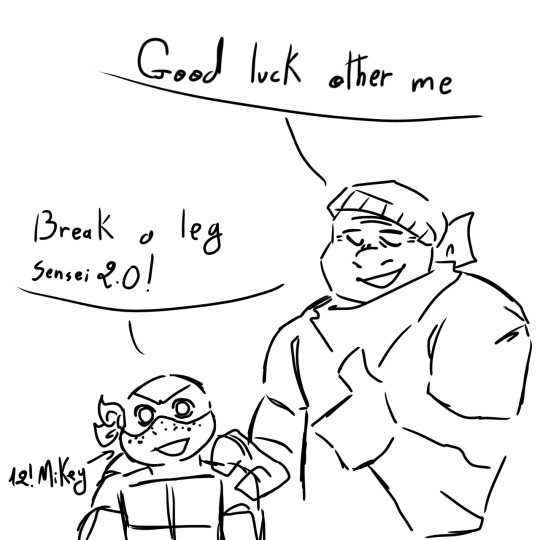
FELLOW RONIN AU 🤝🤝🤝 I ALSO WISH YOU THE BEST OF LUCK


@non-rise-tmnt-au-competition
#YOU. I LOVE YOUR FIC ABT THIS AU WHAT. IM A BIG FAN‼️#A HONOR TO BE ALSO IN THIS COMPETITION WITH YOU#tmnt#sunset linings#peepaw and babies au#tmnt 2012#tmnt the last ronin#tlr lost years#tmnt 2012 mikey#tmnt 2012 donnie#tmnt 2012 raph#tmnt 2012 leo#tmnt michelangelo#tmnt mikey#tmnt moja#tmnt yi#tmnt uno#tmnt odyn#ask#my art#doodles
916 notes
·
View notes
Text
Is 6.5% enough?
Today, there was a leak in the Times that said the independent body who make recommendations on teacher pay has recommended a pay rise of 6.5% for teachers in England for September. Obviously, we don’t know all the details, and funding is a key issue, but is 6.5% enough to save education?
Anecdata, but I recently met up with some friends from my teacher training course. We’re close to hitting the 5 year mark- by which point 1/3 of teachers apparently quit. Except I’m going to be the only one out of five of us teaching in England in September, an attrition rate of 80%. And I don’t think that attrition rate is so unusual, any more.
Right now, on one of the main websites which schools use to advertise vacancies, there are over 12,000 teaching/education jobs being advertised in England. It’s very roughly one vacancy for every two schools. These vacancies won’t be evenly distributed between all schools, so there will be schools in September with huge staff shortages. It’s not an exaggeration to say education is in crisis.
If we got 6.5% (and if it were funded, ensuring all teachers could receive the pay rise), would it make any difference? It’s lower than inflation, after all, and many of the things that we regularly need to buy have gone up by more than inflation in the past year.
As a brief explanation, most teachers in England are paid according to one pay scale. People get a bit more in Inner/outer London and the surrounding areas, but otherwise there’s one set of pay for the whole country. All teachers progress from the starting point M1, to M6, usually at the rate of one pay point a year. The 6.5% would be added on to all of these paypoints.
6.5% would bring M1 (the starting pay point for most qualified teachers) very close to the original Tory promise of a £30,000 starting salary for teachers. At the top of the main pay scale- M6 (which is the point at the pay scale where this would have most impact) it would increase salaries by over £2000 to £41, 332. This would be noticeable in pay packets, enough to reduce people’s financial stresses- which can enable them to cope better with a stressful working environment.
I know some of you will say £40k is a lot, but bear in mind we are talking about a postgraduate qualified professional with at least 6 years of experience. For someone with a chemistry, physics or maths degree, that could be their starting salary in industry. It’s about equivalent to the average salary of a pharmacist. In a capitalist system, pay has to be competitive.
After M6, to increase your pay, you either need to get onto the “upper pay scale��� or take on an extra responsibility payment known as a TLR. Getting on to the upper pay scale used to be relatively automatic, but now it’s much harder. It can certainly take people two or three years to progress from M6 to upper pay scale, and you’re expected to take on “whole school responsibilities” which can amount to a lot of extra work, with not that much of an increase in pay. Increasingly, in England, teacher pay is capped at M6, although there are a lot of older teachers who are on the upper pay scale, and sometimes, they find themselves getting pushed out because they are too expensive. If you move schools, there’s no guarantee of getting a UPS pay point at the new school.
TLRs are even worse in many ways. This is the way that people like heads of department and heads of year are paid. It’s a figure set by your school, within a national range, and there’s no consistency between schools. A Head of Science in one school may get £5000, whilst another only gets £3000. It’s worth noting that it’s also much harder to get a TLR in primary. Because TLRs are often the only way to increase your pay, a lot of people rush to take them on, sometimes in the second or third year of teaching. This often leads to burnout, because people take on massive responsibilities before they are ready, and the consequences can be damaging to everyone around them as well.
I do think 6.5% might be just enough to keep some people who are looking elsewhere from leaving. But the main reason people leave is often work related stress, often euphemistically called “workload”, which is largely being driven by the collapse in other services such as social services, the NHS and social care. “Workload” is also often made worse by being in a short staffed department, so it becomes a vicious cycle. I’ll write more about workload in another post.
However, the point is, the profession is on the brink of collapse. I really do believe that. I think the only way to save education would be to tempt a lot of the recent leavers back in. And 6.5% won’t be enough to do that. I don’t think 10% would be enough to do that. Without tackling the systemic problems within teaching, and without a pay system that really rewards classroom teachers doing the key, every day job that makes education functional, pay increases that don’t even match inflation aren’t enough.
34 notes
·
View notes
Text
Art Deco Rolleicord 1
Some cameras look so amazing that you consider them more of a work of art than a mechanical piece of metal and glass that takes photos. That was my thought the first time I saw the Rolleicord 1. While the Rolleicord 1 is a fairly plain camera, it's the "skin" that gives it a "wow" factor.
It's the same feeling I had when I saw cameras like the cameras designed by Walter Teague, like the Kodak Beau Brownies, The Petite Coquette, and the Gift Kodak. They are more of something you'd see in a museum rather than take out and take photos with.
It has more to do with the Art Deco era; these items were manufactured in, and along with the pride in artistry, the companies had to present something to their audience than we currently have. The fact that a camera company in the 1930s would introduce a new line of cameras with such a striking appearance is a bold statement and a testament to the Rollei name.
The History:
Rollei holds a significant place in photographic history. Founded in 1920 in Braunschweig, Germany, by Paul Franke and Reinhold Heidecke, the company originally bore the name "Franke & Heidecke." Initially, it focused on precision mechanical devices, but by the mid-1920s, Rollei began producing cameras that would revolutionize photography.
Rollei gained international recognition in 1929 with the launch of the Rolleiflex, the first twin-lens reflex (TLR) camera. The Rolleiflex was compact, robust, and designed for medium-format photography. Its unique twin-lens system featured one lens for viewing and focusing and another for capturing the image on film. This innovative design allowed photographers to frame shots at waist level, making candid photography more discreet and practical. The Rolleiflex quickly became a favorite among professionals and enthusiasts, particularly for portrait and documentary work.
The success of the Rolleiflex led to the introduction of the Rolleicord, a more affordable version aimed at amateur photographers. Both models showcased Rollei's commitment to precision engineering and optical excellence, which became hallmarks of the brand.
During the 1930s and 1940s, Rollei continued to innovate, refining the Rolleiflex and Rolleicord lines with features such as automatic film winding and improved optics. Despite the challenges of World War II, the company maintained its reputation for high-quality cameras. In the post-war era, Rollei played a significant role in the resurgence of the German camera industry.
The 1950s and 1960s marked a golden age for Rollei. The Rolleiflex TLR became synonymous with professional photography and was used by renowned photographers such as Richard Avedon, Diane Arbus, and Vivian Maier. Rollei also ventured into other formats and technologies. The Rolleiflex 35mm SLR, introduced in the late 1950s, showcased the company's adaptability to the changing market demands.
By the 1970s, the rise of Japanese camera manufacturers like Nikon, Canon, and Minolta introduced intense competition. These companies offered high-quality single-lens reflex (SLR) cameras at more affordable prices, challenging Rollei's dominance in medium-format and professional photography.
In response, Rollei diversified its product line, introducing the Rolleiflex SL66, a medium-format SLR, and the compact Rollei 35, which became one of its most miniature 35mm cameras. Despite these innovations, Rollei struggled to maintain its market share due to its higher production costs and its competitors' rapidly advancing technology.
In the 1980s and 1990s, Rollei faced financial difficulties, leading to changes in ownership and restructuring. The company shifted focus to digital imaging and niche markets, including high-end studio cameras and digital backs for medium-format systems.
The Rollei legacy endures as a symbol of German engineering and innovation, reflecting a century of dedication to the art and science of photography.
My Camera:
The Rolleicord 1 was made between 1933 and early 1936, with 32,508 units sold. The camera is nickel-plated and decorated with a trompe-l'oeil grid on all sides except the bottom, giving it its unique look. In 1934, Franke & Heideke produced a version of the camera without the beautiful pattern finish and covered the body in drab black leather, which was the Rolleicord 1, model 2.
My Rolleicord 1 is 5.25" tall with the chimney closed and 8" tall with the chimney up, by 4" deep, by 3.5" wide, including the focus knob. It weighs 1 lb, 15.4 oz, so just under 2 lbs. The serial number on the camera is 029789, which is stamped into the body with the back door opened. The camera has a Carl Zeiss Jena Triotar 7.5cm f4.5 lens in a Compur shutter.
The shutter speeds range from 1/300 to 1 sec., along with "B" and "T" settings. For transparency purposes, my shutter isn't in the best condition and only works on the top three speeds (1/300, 1/100, 1/50 sec.). It doesn't close if I use any of the slower speeds. The shutter speeds are set by turning the collar around the lens to the desired shutter speed, which is indicated by a triangle.
The camera's aperture setting ranges from f4.5 to F32. A pointing triangle and a separate collar on the other side of where you set the shutter speed determine the aperture setting.
To cock the shutter, you slide the bar under the lens to the right as you're holding the camera to take a photo. With the same lever, you slide the lever to the left to take the photo. There aren't separate levers for cocking the shutter and tripping the shutter. It's all done with the same bar. Me, I like that, so you're not looking to cock the shutter in one area and take the photo in a different area. Very smooth and easy. There is also a socket for a cable release on the bottom of the shutter at approximately the 7 o'clock position.
To load the camera with film, simply pull the back release on the bottom of the camera, and the back will swing open. To take the empty spool of 120 film from the bottom chamber, you'll need to pull out the film knob on the right, which will allow you to take the empty spool out of the camera.
Pulling out the winding knob will allow you to put the empty spool in the top portion of the camera to advance the film to the next frame. Press the winding knob to keep the empty film spool in place. Put the new roll of film into the bottom chamber and press back in the film knob to keep the roll in place.
Once you have the empty spool on the top and the new roll of film on the bottom, remove the tape that keeps the roll closed, pull the leader over the bottom and top roller, and slide the film's end into the take-up spool slot. Wind the film onto the take-up spool with the advance knob until you see an arrow pointing to the ends of the film. At this point, you can close the back door and wind the film to your first frame.
The frame counter on the left side of my camera body isn't working. Luckily, on the bottom of the camera, there is a red window you can use to see when you're in the first frame. Unfortunately, this numbering system on the film rolls is used for 6x9 format, so using this method, I only got eight images on a roll of 120 film instead of the standard twelve for 6x6 format cameras.
To focus on your subject, pull up the chimney by slightly pulling back the release on the back of the chimney, and pull up, which will expose the large focusing screen. On the right side of the camera is the focusing knob. The focusing distance is from 0.8 meters to infinity. Turn the focusing knob to bring your subject into focus on the screen.
A fine focus magnifier on a spring rests on the back of the chimney. Bring the magnifier around to the top of the viewfinder. Mine stays in place, allowing the photographer to bring their eye closer to the magnifying glass for fine focus. When not using the fine focus magnifier, it can be swung back to the back of the finder so you can see the full image on the focusing screen. You can also slide the front portion of the chimney back and use the chimney as a sport finder if needed.
On the back of the camera is an exposure guide and depth of field scale. This scale was produced in German, French, and English for the different markets. My guide on the back is in German. According to the Rolleicord 1 manual, the exposure guide is rated for DIN 26, which would be ASA/ISO 320
My Results:
It's in the northwest United States in early January, which means very little sunshine. So I loaded up the camera with some 400 ISO film and walked around the neighborhood to see what I could get from this Rolleicord 1 camera. Knowing I only had the top three speeds to work with, this wasn't too much of an issue as the sun was generally behind clouds most of the day; it wasn't that dark out, and it typically shows between 1/300 and 1/100 shutter speed.
Here are some of the results from my Rolleicord 1 camera.
Conclusion:
WOW!!! What a fun camera to shoot with. I forget how much I enjoy shooting with a TLR camera. It reminds me of my wedding shooting days many years ago. Looking down at your subjects and seeing such a nice big image brings back many good memories.
Even though the Rolleicord was made for amateur photographers, the lens is fantastic, easy to use, and excellent Rollei camera quality. I only had to keep reminding myself that when you see something going right in the finder, you need to turn left. If something comes into the frame on the right, it is really on the left in real life. I like the ability to keep things square, and while I prefer a panoramic format, having a square image is interesting and gives a new perspective.
Thank you for taking some time from your day to read about this fantastic camera.
Until next week, please be safe.
#Rollei#Rolleiflex#Rolleicord#TLR#TLR Camera#twin lens reflex#Twin Lens Camera#Franke & Heidecke#germany#German camera#Camera from Germany#120 film#120 camera#120 film camera#Medium format#medium format camera#6x6 camera#6x6 format#carl zeiss#Carl Zeiss Lens#Zeiss#Art Deco#Art Deco 120 camera#art deco camera#Fun Camera#beautiful camera#1930s camera#cameras from 1930s#classic camera#vintage camera
0 notes
Text
ANTIMATTER INDUSTRIES RELEASES THE TLR 7 SUB MICRO WING FOR 365/365XL FRAMES
Antimatter Industries has released their latest offering with the new TLR 7 sub Micro Wing for 365/365XL pattern frames. Antimatter Industries state “Competitive shooters have been using thumb-ledges for many years to help recoil control. Why don’t we see them outside of open division? Standard thumb ledges significantly widen your pistol and need a competition holster not designed for duty…

View On WordPress
0 notes
Link
Check out this listing I just added to my Poshmark closet: Eastman Kodak Brownie Reflex Synchro Vintage Collectible Bakelite Camera w Box.
0 notes
Text
List of Universities in Delhi NCR Based on 2024 Ranking
Every year, different university ranking associations assign ranks to universities on the basis of different variables, including TLR or Teaching, Learning and Resources; RP or Research and Professional Practice; OI or Outreach and Inclusivity and GO or Graduation Outcomes. Among the top universities in Delhi NCR, following is the list of universities based on 2024 ranking:
KIIT or Kalinga Institute of Industrial Technology

Founded in 1992 by the prominent educationist and philanthropist, Dr. Achyuta Samanta, KIIT Deemed to be University ranks 6th Best University in India among 91 institutes that featured in Times Higher Education World University Rankings 2024. The university’s ranking in the Overall category ranges between 601-800 in the World University rankings and 501-600 in the Engineering & Technology category. In the Business & Economics category, the university ranks between 601-800 and between 401-500 in the Computer Science category. Main subjects taught at the university include Engineering & Technology, Psychology, Arts & Humanities, Physical Sciences, Social Sciences and Computer Science and it boasts of 10% international students. The number of students per staff is 12.3 and the student ratio of females to males is 49:51. So, if you want to take up quality higher education at a top ranking university, contact KIIT now!
AIIMS Delhi
One of India’s most chosen medical universities, AIIMS or All India Institute of Medical Sciences came up in 1956 as an Institution of National Importance by an Act of Parliament. Duly recognised by the Medical Council of India and the University Grants Commission, AIIMS ranks right on top in NIRF ranking with a score of 94.32. With its renowned faculty and state-of-the-art facilities, AIIMS offers exceptional research and education opportunities. The institute offers undergraduate (MBBS), postgraduate (MD/MS) and super-specialty but courses but has a strict selection procedure. It is also known for offering highly competitive academic environment.
IIT Delhi
IIT or the Indian Institute of Technology in Delhi ranks among the top autonomous public research universities. It serves as one of the best Centres of Excellence for research, training and development in science, engineering and technology. Ranking 197 in QS World University Rankings 2024 and 2nd in the Engineering and 4th in the Overall category in NIRF Rankings, the university offers high quality education to aspiring students. It even features several financial assistances and scholarship schemes for students to lessen their financial burden.
In conclusion, the landscape of the best ranking universities in Delhi NCR is dynamic and vibrant with the institutions constantly adapting to meet the evolving requirements of the industry.
0 notes
Text
Turtles sanding the competition! Watkin's Training Facility "The Fall Event 2023 w/ Razz & SPE"
#arrma #arrmatyphontlr #arrmarc #arrmaarmy #teamassociated #hobbyetc #TLR #hobbywing #hobbywingesc #rccars #rccarsofinstagram #rccar #rcracing #rcracinglife #spektrum #ecoboost #sanwa #mx6 #brushless
https://www.instagram.com/reel/CxT4hQRMAdc/?igshid=MTc4MmM1YmI2Ng==
0 notes
Text
@butterfilledpockets
@less-depresso-more-espresso
#tlr competition#the last ronin competition#tlr competition polls#tlr competition final poll#i almost forgot to post this
185 notes
·
View notes
Note
You won round 3 incase you didn’t notice.
Anyways do you think there’s enough tlr AU’s to make a competition for it?
I might just make one for fanfic recs honestly
I DID NOTICE!!!!!!!!!
THE PEEPAW SWEEP IS SLOW BUT STEADY. PEEPAW WORLD DOMINATION‼️🫵‼️‼️‼️
and honestly? im not sure? i actually know of only two others :,[
24 notes
·
View notes
Text
Illuminate Research Task
Here is my groups research on 5 photographers who use light painting techniques.
Amanda Friedman
Amanda Friedman is an American based photographer who’s photographic specialty lies between commercial and fine art photography. After receiving a BFA in photography at Rochester University, Friedman moved to LA where she later began photographing a series of night landscapes, using both natural and artificial light to produce creative effects. Friedman first began this series after capturing a night landscape on a foggy night in New York City. She shot a role of 120mm on her TLR and the results proved to be an unexpected surprise, thus inspiring her to produce a collection of beautiful images across a fifteen year time span. She captures all of her images using medium and large format cameras and using no digital manipulation in the process.
Below are some examples of her work.
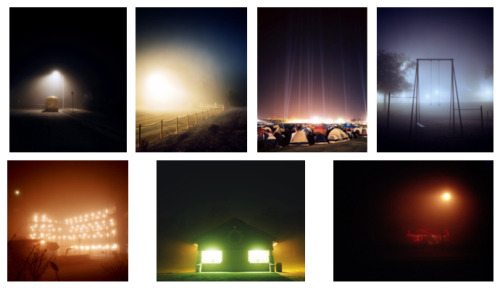
I particularly like the top image of the tents in the campsite. This image is powerful in that the horizontal direction of the lights carries the eye from the bottom of the picture to the top. The brightest part of the photo indicates that white light is being projected from a stadium or arena, which has therefore helped to retain light and color in the foreground. This intensity of light has perhaps allowed the photographer to shoot with a tripod at a low shutter speed in order to achieve the desired effect. The natural vignetting in the photo again focuses the eye to the most interesting elements of the image and amplifies the lighting further. The overall quality of the image is good and presents little noise. This again has been helped by the use of tripod and large format of the camera. Although not directly painting light within the scene, the photographer has used the available light sources to produce a creative effect.
Lance Keimig
Lance Keimig is an American photographer who specialises in night and low light photography. After picking up a camera at an early age, Lance quickly began experimenting with long exposures and how light can be used to enhance this to change the entire mood or feel of an image. After developing a successful career as a photographer, Keimig decided to follow in the footsteps of his mentor and take up teaching. Since then he has taught classes and workshops on night photography across the globe.
Starting on film, his first experience with long exposure photography involved waving torches in-front of an AE1 just to see what happened. This experimentation lead him to explore the possibilities of using this particular lighting technique.

The above images present a variety of Keimig’s work, highlighting a broad range of work, from black and white to large expansive landscapes and some to smaller, intimate buildings. Throughout the images the light has been sculpted and crafted to evoke a feeling and response from the viewer. The variety of colours and tones, along with the direction of light create an effective which may not have came through with the natural light of the place.
O. Winston Link
O. Winston Link was born in 1914 in Brooklyn, New York. His first photograph was taken on a borrowed medium format, Kodak camera and by the time he had left school, he had built his own enlarger. His technique was making ‘posed photographs’ appear candid, whilst still showcasing a creative element. Link had a keen interest in railroads and whilst on commission for an industrial photography project in Virginia 1955, he captured his first night photograph of a railroad. A few months later, steam trains were taken over by diesel and it was then that Link’s work became a realised documentation of the end of the steam train era. By 1960, he’d accumulated 2400 negatives from this project (the below image is one of the most recognised.)
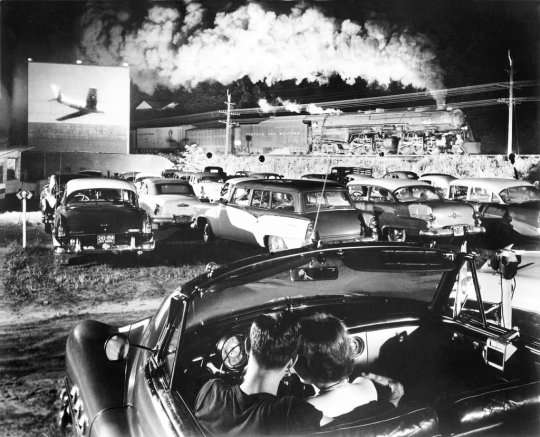
The majority of his work was photographed at night and each of his photos were were always meticulously composed. He once said; “I can’t move the sun - and it’s always in the wrong place - and I can’t even move the tracks, so I had to create my own environment through lighting”.
Link’s vision required him to develop new techniques for flash photography when photographing such large subjects. For example, the movie theater image ‘Hotshot Eastbound’ used 42 flashbulbs, all of which fired simultaneously. He used a large format camera which was loaded one sheet of film at a time. He used bulb lights in large cone-shaped holders (as seen below) which directed the light towards the subject. To highlight the texture and metallic surface of the trains, he used a high powered light directed from an angle to reflect off the train. This was the opposite technique for lighting people in his shots, whereby he would create a softer light source to clearly define both subject matters.

Tim Simmons
Tim Simmons is a UK based photographer who uses photography and film to explore themes of time, motion and place. Through his images, he aims to encourage a unique perspective of landscapes. Simmons’ images are captured using a large format camera combined with artificial lighting to produce a surreal and peculiar look. He often enhances natural lighting by using artificial lighting to sharpen the image; giving it an intense clarity and a greater sense of mystery and expectation. His locations are always carefully researched.
The below images were taken at twilight, using a combination of natural light with artificial light. The natural light of the sky is helping illuminate the subject/surrounding area and the added light (possibly LED or Flash) is helping control the light falling on the subject/object/area etc. This is especially important in the top image due to the similarity in colour of the object and the background sky. if the object was not lit with an added artificial light then it would be lost in the scene and the contrasting shadows wouldn’t be visible. This is why Simmons uses this particular lighting technique, in order to showcase a strong creative element to his photos which provide great visual impact.
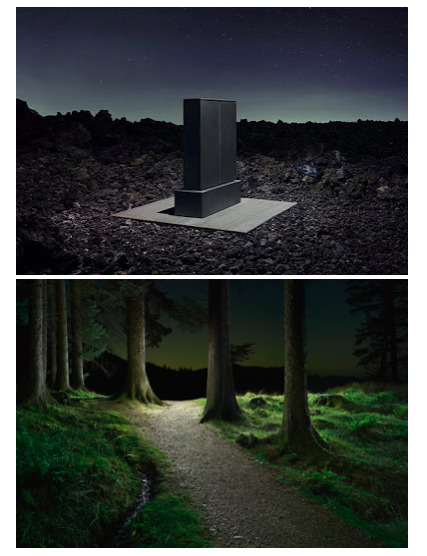
John Hartman
John Hartman is a well accomplished American photographer who specializes in ‘light painting photography’. His use of this technique has won him great recognition, including one of his images being selected as within the top ten photos worldwide in the 2016 international competition of the professional photographers of America.
His highly complex method of shooting involves using special LED lights to compose a series of images of the same subject, but from various vantage points. He then blends the exposures into one single photograph which helps to depict the subject in a way impossible to achieve using any other photographic technique.
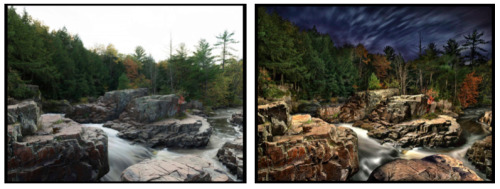
The first photo portrays a landscape scene with a long exposure. The scorched sky and contrasting trees and scales do not attract the eye. The second picture is much more dynamic, with more depth and visual impact. The photographer achieves the shot by lighting specific individual elements of the photo. I’m unsure as to how the photographer has lit the sky, however, many of the techniques may have been executed post production. Using LED light from a side angle has produced depth of contrast in the highlights and shadows. The added clarity gives the image an overall more professional look.
9 notes
·
View notes
Photo

"Kohana" was an Orca raised in captivity at SeaWorld and then "sold" to Loro Parque in Spain to perform for humans. Orca aren't meant to be kept in concrete cages, or concrete jungles - they're meant to be free out in the open. Kohana died Sept 14, 22. I thought it fitting to name my Spanish @orbea Orca M20iLTDin her memory. The sticker on the top tube is actually Kohana - she was known for playing games with her trainers with leaves. I guess when you're trapped, anything can be a toy. Like an Orca, this bike is an absolute weapon! Crazy fast yet still compliant. Kohana cuts through the air and flies up hills unlike any other bike. Full carbon frame and fork, seatpost and handlebars with @vision_tech_usa SC 40 carbon wheels and @vittoriatires Corsa Control Competition G2.0 TLR 700x30c tires deliver an unparalleled ride - smooth AND efficient. Internal hose routing and aero shapes cheat the wind. @shimanoroad Ultegra Di2 2x12-speed electronic shifting is fast and precise. I've set custom shift patterns for automatic shifting of the front derailleur, with it's 52-36 chainrings. Ultegra hydraulic disk brakes stop Kohana in a heart beat. @4iiiicom Precision Pro dual-sided power meters to make the most of my training. I'll share the custom screen on my @garmincycling Edge 520 Plus bike computer later. @selle_italia SLR Boost SuperFlow L Carbon Keramic Rail with an @axiomgear Seymour Oceanweave Wedge 1.3 seatbag and @lizardskinscycling DSP bar tape finish the cockpit. Cool fact about the seatbag - it's made from plastic from re-claimed fishing nets! @supacaz Fly Cage Carbon hologram bottle cages finish the look. Can we talk about the paint and finish on this bike? Bourdeaux and raw carbon mix - the colour seems to flow like blood under the clearcoat. You don't look at this paint, but into it. It's captivating and mesmerizing! #OrbeaBicycles #OrbeaOrca #myridemyrules #destinationroad #shimano #garmin #Kohana #cyclelife #mycyclelife #4iii #visiontech #capturaphoto #captura #apsley #northkawartha #ontario #canada #outdoors #churchoftheskinnytire (at Kawartha Highlands Provincial Park) https://www.instagram.com/p/CkI4r0ZONzX/?igshid=NGJjMDIxMWI=
#orbeabicycles#orbeaorca#myridemyrules#destinationroad#shimano#garmin#kohana#cyclelife#mycyclelife#4iii#visiontech#capturaphoto#captura#apsley#northkawartha#ontario#canada#outdoors#churchoftheskinnytire
0 notes
Link
Check out this listing I just added to my Poshmark closet: Eastman Kodak Brownie Reflex Synchro Vintage Collectible Camera With Box.
0 notes
Text
39 notes
·
View notes
Text
Hepatitis B Virus Infection - Global Drug Forecast and Market Analysis to 2029 published on
https://www.sandlerresearch.org/hepatitis-b-virus-infection-global-drug-forecast-and-market-analysis-to-2029.html
Hepatitis B Virus Infection - Global Drug Forecast and Market Analysis to 2029
Hepatitis B Virus Infection – Global Drug Forecast and Market Analysis to 2029
Summary
Chronic hepatitis B (CHB) is a serious liver disease caused by the failure of viral clearance following acute hepatitis B virus (HBV) infection. The global disease burden is high in the nine major markets (9MM: US, France, Germany, Italy, Spain, UK, Japan, Brazil, and China); it is especially high in China. For most patients, CHB is a lifelong disease that cannot be cured, with only a very small number of patients entering remission each year. Patients with CHB have a 20% risk of developing life-threatening liver disease, such as cirrhosis and hepatocellular carcinoma (HCC) as a result of their condition. Guidelines by the American Association of the Study of Liver Diseases (AASLD) and the European Association for the Study of Liver (EASL) have recommended CHB to be treated with nucleotide analogs (NA).
Gilead Sciences and Bristol Myers Squibb (BMS) are the major players within the CHB market with their nucleotide analogs Viread (TDF, Gilead), Vemlidy (TAF, Gilead) and Baraclude (entecavir, BMS). However, generic versions of TDF and entecavir dominate the 9MM. The CHB treatment pipeline is predominantly in early stages. Gilead’s TLR-8 agonist selgantolimod, J&J’s capsid assembly modulator JNJ-6379, and antisense nucleotide JNJ-3898 could significantly impact the CHB market across the 9MM. Also Replicor, Assembly Biosciences, and Ionis Pharmaceuticals are developing CHB therapies. A major unmet for CHB treatment remains the potential to achieve functional cure.
Key Highlights
– During the 10-year forecast period, there are six major pipeline products that are on track to launch, driving a forecast growth in the 9MM from $3.8B in 2019 to $5.2B in 2029, which represents a CAGR of 3.1%. – To combat the unmet need of a functional cure, companies such as Gilead, J&J, Replicor, Ionis, and Assembly Biosciences are developing pipeline products with novel mechanism of action, with the potential of being used as a combination therapy either with current nucleotide analogs or with emerging products. – The pipeline products are expected to launch in the second half of the forecast period in 2029. Antisense nucleotides are expected to gain a market share of 14.7% and sales of $761M in the 9MM by 2029. However, capsid assembly modulators from J&J and a toll-like receptor 8 agonist from Gilead are expected to compete with antisense nucleotides for market shares in the 9MM by the end of the forecast period.
Key Questions Answered
– How will the CHB market landscape in the 9MM (US, France, Germany, Italy, Spain, UK, Japan, Brazil, China) change from 2019-2029? – What are the most promising late-stage pipeline products for CHB treatment? – How do the clinical and commercial attributes of late-stage pipeline products compare with one another, and against existing CHB treatment options? – What are the remaining unmet needs in CHB treatment? – What drivers and barriers will affect CHB treatment sales in the 9MM over the forecast period?
Scope
– Overview of CHB, including epidemiology, etiology, pathophysiology, symptoms, diagnosis, and current management strategies. – Topline CHB treatment market revenue from 2019-2029. Annual cost of therapy and major pipeline product sales in this forecast period are included. – Key topics covered include current CHB treatment, unmet needs and opportunities, and the drivers and barriers affecting CHB treatment sales in the 9MM. – Pipeline analysis: comprehensive data split across different phases, emerging novel trends under development, synopses of innovative early-stage projects, and detailed analysis of late-stage pipeline products. – Analysis of the current and future market competition in the global CHB treatment market. Insightful review of the key industry drivers, constraints, and challenges. Each trend is independently researched to provide qualitative analysis of its implications.
Reasons to Buy
The report will enable you to – – Develop and design your in-licensing and out-licensing strategies through a review of pipeline products and technologies, and by identifying the companies with the most robust pipeline. – Develop business strategies by understanding the trends shaping and driving the global Hepatitis B Virus Infection market. – Drive revenues by understanding the key trends, innovative products and technologies, market segments, and companies likely to impact the Hepatitis B Virus Infection market in the future. – Formulate effective sales and marketing strategies by understanding the competitive landscape and by analyzing the performance of various competitors. – Identify emerging players with potentially strong product portfolios and create effective counter-strategies to gain a competitive advantage. – Organize your sales and marketing efforts by identifying the market categories and segments that present maximum opportunities for consolidations, investments, and strategic partnerships.
0 notes